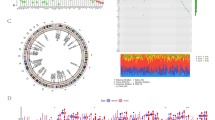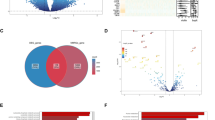Abstract
Background
Homologous recombination (HR) is a key pathway in DNA double-strand damage repair. HR deficiency (HRD) occurs more commonly in triple-negative breast cancers (TNBCs) than in other breast cancer subtypes. Several clinical trials have demonstrated the value of HRD in stratifying breast cancer patients into distinct groups based on their responses to poly(ADP ribose) polymerase inhibitors and chemotherapy.
Methods
We retrospectively collected TNBC samples to establish a multiomics cohort (n = 343) and explored the biological and phenotypic mechanisms underlying the better prognosis of patients with high HRD scores. Gene set enrichment analysis was conducted to elucidate the underlying pathways in patients with low HRD scores, and a radiomics model was established to predict the HRD score via a noninvasive method.
Results
Multivariable Cox analysis revealed the independent prognostic value of a low HRD score (hazard ratio 2.20, 95% confidence interval 1.05–4.59; p = 0.04). Furthermore, amino acid and lipid metabolism pathways were highly enriched in tumors from patients with low HRD scores, which was also demonstrated by differential abundant metabolite analysis. A noninvasive radiomics method was developed to predict the HRD status and it performed well in the independent validation cohort (support vector machine model: area under the curve [AUC] 0.739, sensitivity 0.571, and specificity 0.824; logistic regression model: AUC 0.695, sensitivity 0.571, and specificity 0.882).
Conclusions
We revealed the prognostic value of the HRD score, predicted the HRD status with noninvasive radiomics features, and preliminarily explored druggable targets for TNBC patients with low HRD scores.




Similar content being viewed by others
References
Waks AG, Winer EP. Breast cancer treatment: a review. JAMA. 2019;321(3):288–300.
Criscitiello C, Azim HA Jr, Schouten PC, Linn SC, Sotiriou C. Understanding the biology of triple-negative breast cancer. Ann Oncol. 2012;23(6):vi13-18.
Denkert C, Liedtke C, Tutt A, von Minckwitz G. Molecular alterations in triple-negative breast cancer—the road to new treatment strategies. Lancet. 2017;389(10087):2430–42.
Metzger-Filho O, Tutt A, de Azambuja E, et al. Dissecting the heterogeneity of triple-negative breast cancer. J Clin Oncol. 2012;30(15):1879–87.
Lehmann BD, Bauer JA, Chen X, et al. Identification of human triple-negative breast cancer subtypes and preclinical models for selection of targeted therapies. J Clin Invest. 2011;121(7):2750–67.
Burstein MD, Tsimelzon A, Poage GM, et al. Comprehensive genomic analysis identifies novel subtypes and targets of triple-negative breast cancer. Clin Cancer Res. 2015;21(7):1688–98.
Jiang YZ, Ma D, Suo C, et al. Genomic and transcriptomic landscape of triple-negative breast cancers: subtypes and treatment strategies. Cancer Cell. 2019;35(3):428-440 e425.
Belli C, Duso BA, Ferraro E, Curigliano G. Homologous recombination deficiency in triple negative breast cancer. Breast. 2019;45:15–21.
Brown JS, O’Carrigan B, Jackson SP, Yap TA. Targeting DNA repair in cancer: beyond PARP inhibitors. Cancer Discov. 2017;7(1):20–37.
Yang H, Jeffrey PD, Miller J, et al. BRCA2 function in DNA binding and recombination from a BRCA2-DSS1-ssDNA structure. Science. 2002;297(5588):1837–48.
Pellegrini L, Yu DS, Lo T, et al. Insights into DNA recombination from the structure of a RAD51-BRCA2 complex. Nature. 2002;420(6913):287–93.
Lord CJ, Ashworth A. PARP inhibitors: synthetic lethality in the clinic. Science. 2017;355(6330):1152–8.
Ashworth A, Lord CJ. Synthetic lethal therapies for cancer: What’s next after PARP inhibitors? Nat Rev Clin Oncol. 2018;15(9):564–76.
Timms KM, Abkevich V, Hughes E, et al. Association of BRCA1/2 defects with genomic scores predictive of DNA damage repair deficiency among breast cancer subtypes. Breast Cancer Res. 2014;16(6):475.
Abkevich V, Timms KM, Hennessy BT, et al. Patterns of genomic loss of heterozygosity predict homologous recombination repair defects in epithelial ovarian cancer. Br J Cancer. 2012;107(10):1776–82.
Birkbak NJ, Wang ZC, Kim JY, et al. Telomeric allelic imbalance indicates defective DNA repair and sensitivity to DNA-damaging agents. Cancer Discov. 2012;2(4):366–75.
Popova T, Manié E, Rieunier G, et al. Ploidy and large-scale genomic instability consistently identify basal-like breast carcinomas with BRCA1/2 inactivation. Cancer Res. 2012;72(21):5454–62.
Telli ML, Timms KM, Reid J, et al. Homologous recombination deficiency (HRD) score predicts response to platinum-containing neoadjuvant chemotherapy in patients with triple-negative breast cancer. Clin Cancer Res. 2016;22(15):3764–73.
The Cancer Genome Atlas Network. Comprehensive molecular portraits of human breast tumours. Nature. 2012;490(7418):61–70.
Shah SP, Roth A, Goya R, et al. The clonal and mutational evolution spectrum of primary triple-negative breast cancers. Nature. 2012;486(7403):395–9.
Foulkes WD, Stefansson IM, Chappuis PO, et al. Germline BRCA1 mutations and a basal epithelial phenotype in breast cancer. J Natl Cancer Inst. 2003;95(19):1482–5.
**ao Y, Ma D, Yang YS, Yang F, Ding JH, Gong Y, Jiang L, Ge LP, Wu SY, Yu Q, Zhang Q, Bertucci F, Sun Q, Hu X, Li DQ, Shao ZM, Jiang YZ. Comprehensive metabolomics expands precision medicine for triple-negative breast cancer. Cell Res. 2022;32(5):477-490. https://doi.org/10.1038/s41422-022-00614-0.
Jiang YZ, Ma D, Suo C, et al. Genomic and transcriptomic landscape of triple-negative breast cancers: subtypes and treatment strategies. Cancer Cell. 2019;35(3):428-440.e425.
Ritchie ME, Phipson B, Wu D, et al. limma powers differential expression analyses for RNA-sequencing and microarray studies. Nucleic Acids Res. 2015;43(7):e47.
Yu G, Wang LG, Han Y, He QY. clusterProfiler: an R package for comparing biological themes among gene clusters. OMICS. 2012;16(5):284–7.
Friedman J, Hastie T, Tibshirani R. Regularization paths for generalized linear models via coordinate descent. J Stat Softw. 2010;33(1):1–22.
**ao Y, Ma D, Zhao S, et al. Multi-omics profiling reveals distinct microenvironment characterization and suggests immune escape mechanisms of triple-negative breast cancer. Clin Cancer Res. 2019;25(16):5002–14.
Tutt A, Ashworth A. The relationship between the roles of BRCA genes in DNA repair and cancer predisposition. Trends Mol Med. 2002;8(12):571–6.
Sharma P, Barlow WE, Godwin AK, et al. Impact of homologous recombination deficiency biomarkers on outcomes in patients with triple-negative breast cancer treated with adjuvant doxorubicin and cyclophosphamide (SWOG S9313). Ann Oncol. 2018;29(3):654–60.
Mayerhoefer ME, Materka A, Langs G, et al. Introduction to radiomics. J Nucl Med. 2020;61(4):488–95.
Liu Z, Wang S, Dong D, et al. The applications of radiomics in precision diagnosis and treatment of oncology: opportunities and challenges. Theranostics. 2019;9(5):1303–22.
Gillies RJ, Kinahan PE, Hricak H. Radiomics: images are more than pictures. Data Radiol. 2016;278(2):563–77.
Aerts HJ, Velazquez ER, Leijenaar RT, et al. Decoding tumour phenotype by noninvasive imaging using a quantitative radiomics approach. Nat Commun. 2014;5:4006.
Liu Z, Meng X, Zhang H, et al. Predicting distant metastasis and chemotherapy benefit in locally advanced rectal cancer. Nat Commun. 2020;11(1):4308.
Huang YQ, Liang CH, He L, et al. Development and validation of a radiomics nomogram for preoperative prediction of lymph node metastasis in colorectal cancer. J Clin Oncol. 2016;34(18):2157–64.
Sun R, Limkin EJ, Vakalopoulou M, et al. A radiomics approach to assess tumour-infiltrating CD8 cells and response to anti-PD-1 or anti-PD-L1 immunotherapy: an imaging biomarker, retrospective multicohort study. Lancet Oncol. 2018;19(9):1180–91.
Trebeschi S, Drago SG, Birkbak NJ, et al. Predicting response to cancer immunotherapy using noninvasive radiomic biomarkers. Ann Oncol. 2019;30(6):998–1004.
Farmer H, McCabe N, Lord CJ, et al. Targeting the DNA repair defect in BRCA mutant cells as a therapeutic strategy. Nature. 2005;434(7035):917–21.
Robson M, Im SA, Senkus E, et al. Olaparib for metastatic breast cancer in patients with a germline BRCA mutation. N Engl J Med. 2017;377(6):523–33.
Tutt ANJ, Garber JE, Kaufman B, et al. Adjuvant olaparib for patients with BRCA1- or BRCA2-mutated breast cancer. N Engl J Med. 2021;384(25):2394–405.
Minckwitz GV, Timms K, Untch M, et al. Prediction of pathological complete response (pCR) by homologous recombination deficiency (HRD) after carboplatin-containing neoadjuvant chemotherapy in patients with TNBC: results from GeparSixto. J Clin Oncol. 2015;33(15 Suppl):1004.
Tutt A, Tovey H, Cheang MCU, et al. Carboplatin in BRCA1/2-mutated and triple-negative breast cancer BRCAness subgroups: the TNT Trial. Nat Med. 2018;24(5):628–37.
Jiang YZ, Liu Y, ** and genomic profiling expand precision medicine in refractory metastatic triple-negative breast cancer: the future trial. Cell Res. 2021;31(2):178–86.
Gong Y, Ji P, Yang YS, et al. Metabolic-pathway-based subty** of triple-negative breast cancer reveals potential therapeutic targets. Cell Metab. 2021;33(1):51-64.e9.
**ao Y, Ma D, Yang YS, et al. Comprehensive metabolomics expands precision medicine for triple-negative breast cancer. Cell Res. 2022;32(5):477–90.
Acknowledgments
The authors thank the staff of the Radiology Department of Fudan University Shanghai Cancer Center for their assistance with the breast MRI collection. In addition, they thank the staff of the Institute of Science and Technology for Brain-Inspired Intelligence of Fudan University for their contribution to radiomics feature extraction.
Funding
This project was supported by grants from the National Natural Science Foundation of China (81901703, 82071878, 91959207 and 92159301), Cancer Research Program of National Cancer Center (NCC201909B06), Youth Medical Talents-Clinical Imaging Practitioner Program [SHWRS(2020)_087] and Clinical Research Plan of SHDC (SHDC2020CR2008A).
Author information
Authors and Affiliations
Contributions
All authors fundamentally contributed to this study, participated sufficiently, and take public responsibility for the content. CY designed the study; CY and GHS performed the literature review; and Guan-Hua Su drafted the manuscript. CY, GHS and LJ collected the data. CY and GHS were responsible for quality control and interpretation of the data. LJ and GHS were involved in the statistical analysis and interpreted the results. RCZ and HW were involved in the MR radiomics extraction. CY, GHS, YX and YZJ interpreted the results and edited the manuscript. WJP and ZMS edited the manuscript. CY and YJG edited and finalized the manuscript. The publication was approved by all authors.
Corresponding authors
Ethics declarations
Conflict of interest
Guan-Hua Su, Lin Jiang, Yi **ao, Ren-Cheng Zheng, He Wang, Yi-Zhou Jiang, Wei-Jun Peng, Zhi-Ming Shao, Ya-Jia Gu, and Chao You declare no competing financial or nonfinancial interests.
Availability of data and materials
The accession number for raw LC-MS data, microarray data and sequence data reported in this paper is NODE: OEP000155. All data can be viewed in The National Omics Data Encyclopedia (NODE) (http://www.biosino.org/node) by pasting the accession (OEP000155) into the text search box or through the URL: http://www.biosino.org/node/project/detail/OEP000155.
Ethics approval and consent to participate
The Institutional Review Board approved this study.
Consent for publication
Written informed consent was obtained from all subjects (patients) in this study.
Additional information
Publisher's Note
Springer Nature remains neutral with regard to jurisdictional claims in published maps and institutional affiliations.
Supplementary Information
Below is the link to the electronic supplementary material.
Rights and permissions
About this article
Cite this article
Su, GH., Jiang, L., **ao, Y. et al. A Multiomics Signature Highlights Alterations Underlying Homologous Recombination Deficiency in Triple-Negative Breast Cancer. Ann Surg Oncol 29, 7165–7175 (2022). https://doi.org/10.1245/s10434-022-11958-7
Received:
Accepted:
Published:
Issue Date:
DOI: https://doi.org/10.1245/s10434-022-11958-7




